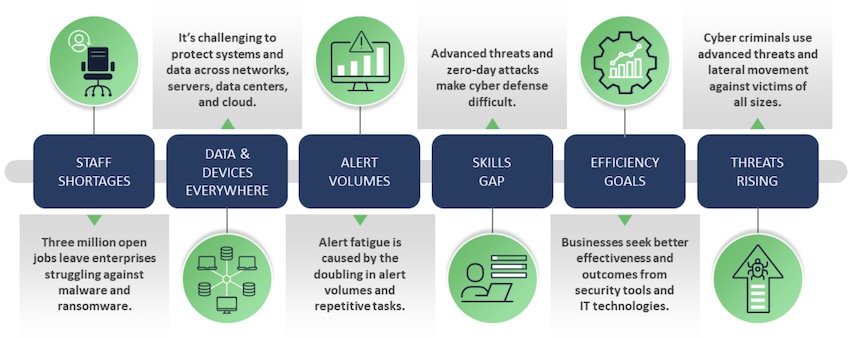10 min read
The rising level of security threats and public incidents demand new approaches to people, processes, and technology that optimize manual processes and harness the benefits of automation. Automation and machine learning (ML) remove inefficiencies and the potential for error or security gaps. While programmatic threat detection and incident response minimize false positives along with staff and skill shortages, it is not a panacea or quick fix. Human analysts are still the most vital link in cybersecurity defense that differentiates you in the marketplace.
Trends Driving Adoption of Automation
There are six top trends prompting Managed Service Providers (MSPs) and enterprises to embrace automated threat detection and response. In addition to challenges in hiring and retaining hard-to-find cybersecurity professionals, there are hidden costs inherent in the massive amounts of alerts that can trigger false positives.

In light of global IT challenges like staff shortages, ML and automated threat detection and response enhance efficiency, job satisfaction, and retention of cybersecurity experts – whether in Netsurion’s Security Operations Center (SOC) or partner and customer environments.
However, some inhibitors of automation and ML include the lack of talent to implement, the time and cost involved, and a focus on day-to-day security operations.
Benefits and Challenges of Automation
Cybersecurity incorporates automation, machine learning (ML), and artificial intelligence (AI) to accelerate threat correlation and reduce incident response times when minutes matter. Rising labor costs are often the catalyst to exploring automation benefits. A more programmatic threat defense improves efficiency and effectiveness by:
- Enhancing threat correlation in real-time
- Reducing “noise” and false positives that waste analyst attention
- Providing threat context and actionable intelligence
- Accelerating a rapid response
It can also be used to chain together seemingly disparate insights that can reveal more persistent and advanced threats lurking stealthily in your organization. Ideally, automation enhances Security Operations Center (SOC) analyst effectiveness by streamlining routine tasks and providing insight and threat context that results in better decision making.
However, some inhibitors of automation and ML include the time and cost involved, as well as a focus on day-to-day security operations instead of future-oriented SecOps improvements. Another downside of automation and ML is the human expertise needed to develop the algorithms and ongoing system tuning and optimization.
Advantages and Pitfalls of Human Experts
Given the shortage of cybersecurity staff to fill an estimated 3 million IT and security role, it’s no wonder that automation and machine learning is viewed as a viable solution to the ongoing IT staff and cybersecurity skills shortage. A proactive defense requires constant vigilance and robust security operations. Security must work in tandem with automation and ML along with dedicated experts to implement defense-in-depth protection and future-proof your security investment.
One of the arguments against human-led threat response is that it is labor intensive and therefore more expensive. But the security gap or technology misstep that results in a data breach is equally costly in terms of damaged brand reputation, lost customers and revenue, and possible compliance fines.
Pitfalls of humans include time away due to vacation or training as well as the key challenges of hiring and retaining security experts in the first place. If you don’t have the expertise or an in-house SOC, leverage 24/7/365 SOC experts like Netsurion to augment your team and customize cybersecurity to customer environments.
A Blend of Security Automation and Human Expertise is Needed
Cybersecurity experts are needed to architect the customer solution, prepare the necessary runbooks and playbooks, tailor and prioritize threat detection, respond to suspicious events and possible incidents, and enhance threat remediation over time. While automation and machine learning are leveling the playing field for small-to-medium-sized businesses (SMBs) and their service providers, it doesn’t stand alone. Humans are still needed to reduce business and cybersecurity risk and assess qualitative and quantitative results over time. Some IT decisions have performance and productivity impacts, so incorporate humans in-the-loop when blocking devices and quarantining access to users for the first time. MSSPs must demonstrate why a two-pronged approach of automation and human-led cybersecurity is warranted.
Evolve From Alerts to Proactive Threat Response
Overcoming advanced and morphing threats requires more mature technology, skilled people, and rapid incident response than in years past. Service providers must blend automation and ML along with dedicated security experts to implement defense-in-depth protection and future-proof security investments used by their customers. To enhance customer resilience, balance the best of both options – human and artificial intelligence. Netsurion provides a comprehensive managed service and complete platform for MSSPs to predict, prevent, detect, and respond to escalating threats.

Paula Rhea
Paula Rhea, CISSP is a product marketing manager at Netsurion. She is responsible for developing go-to-market strategies for customers and partners regarding managed threat protection and secure edge networking. Paula has extensive cybersecurity experience in managed services, compliance, and endpoint protection.

